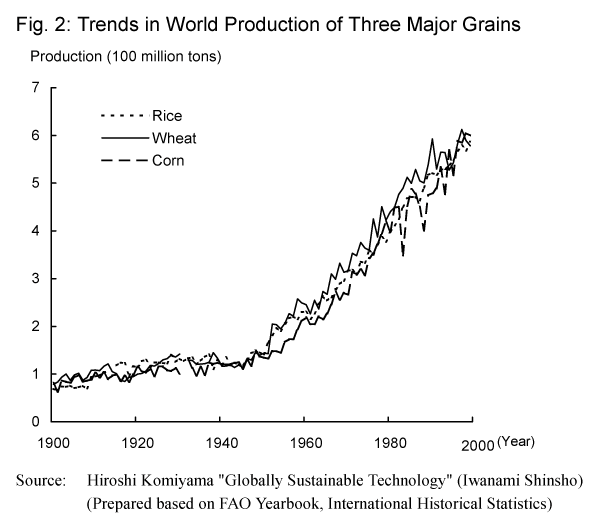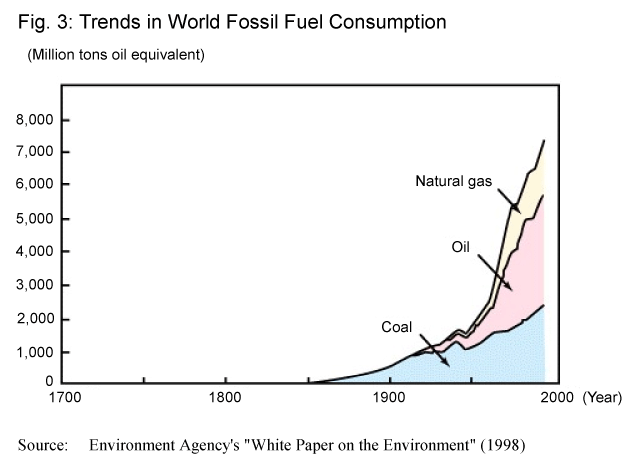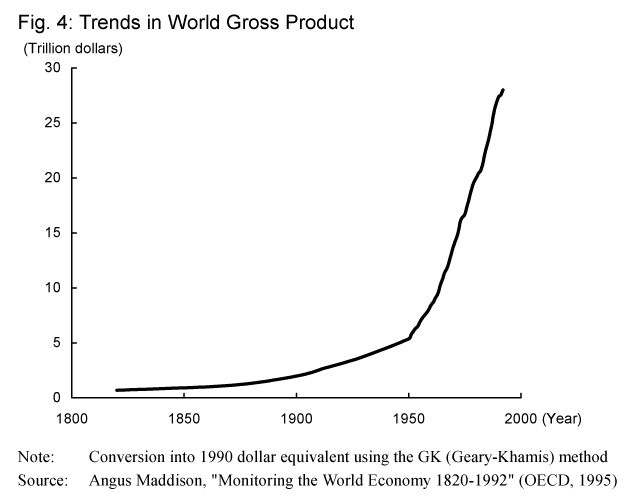| Home > Policy > White Paper, Notice, Announcement > White Paper > Annual Report on the Promotion of Science and Technology 2000 > Part1 Chapter1 (2) | ||
![]() Food production is strongly linked to change in population
during the 20th century. Total world production of the three major grains (wheat,
rice and corn) has increased dramatically from around 1950 ( Fig.
2 ).
Food production is strongly linked to change in population
during the 20th century. Total world production of the three major grains (wheat,
rice and corn) has increased dramatically from around 1950 ( Fig.
2 ).

![]() The dramatic development in agricultural technology has contributed
to this expansion in food production.
The dramatic development in agricultural technology has contributed
to this expansion in food production.
![]() In addition, mankind has expanded production activities and
developed mining and manufacturing. The production of raw materials to support
mining and manufacturing has also increased dramatically from around 1950.
In addition, mankind has expanded production activities and
developed mining and manufacturing. The production of raw materials to support
mining and manufacturing has also increased dramatically from around 1950.
![]() This expansion in mining and manufacturing activities has
increased mankind's energy consumption. From the beginning of the 20th century,
energy consumption for mining, manufacturing and transporting has increased dramatically,
and the consumption of fossil fuels responsible for that increase has grown rapidly
from around the middle of the 20th century ( Fig.
3 ).
This expansion in mining and manufacturing activities has
increased mankind's energy consumption. From the beginning of the 20th century,
energy consumption for mining, manufacturing and transporting has increased dramatically,
and the consumption of fossil fuels responsible for that increase has grown rapidly
from around the middle of the 20th century ( Fig.
3 ).

![]() Such an expansion of the activities of mankind promoted economic
development. Total Gross World Production, converted into 1990 dollars, is considered
to increase from approximately 2 trillion dollars at the beginning of the 20th
century to its current level of 30 trillion dollars ( Fig.
4 ). Growth has been particularly marked in the second half of the 20th century.
Such an expansion of the activities of mankind promoted economic
development. Total Gross World Production, converted into 1990 dollars, is considered
to increase from approximately 2 trillion dollars at the beginning of the 20th
century to its current level of 30 trillion dollars ( Fig.
4 ). Growth has been particularly marked in the second half of the 20th century.

![]() In this way, as the growth in human activities in the 20th
century is characterized by mass production, the affluence in goods is considered
to be equivalent to the affluence of society.
In this way, as the growth in human activities in the 20th
century is characterized by mass production, the affluence in goods is considered
to be equivalent to the affluence of society.
| Back to Top | MEXT HOME |